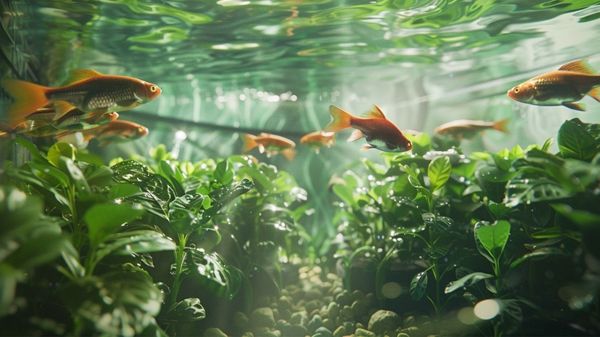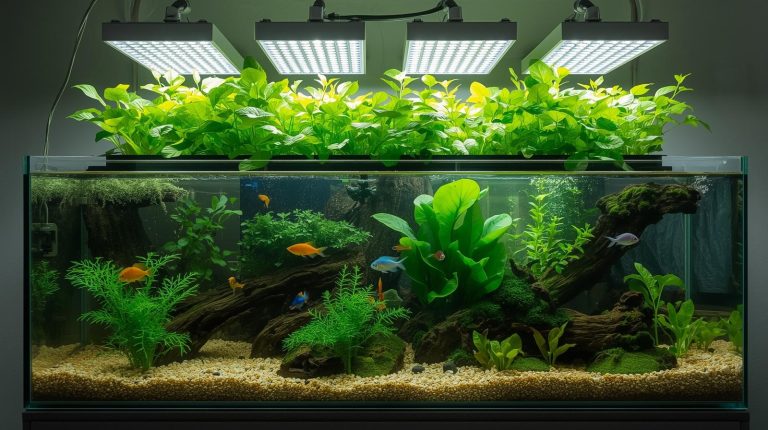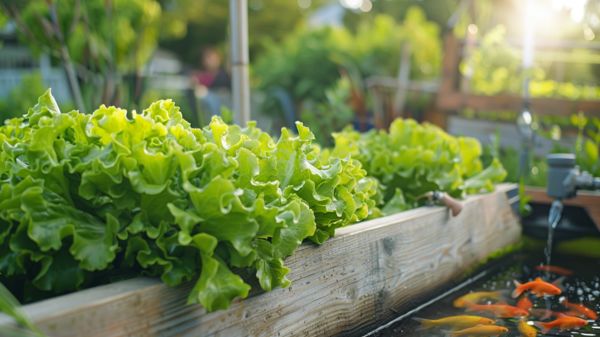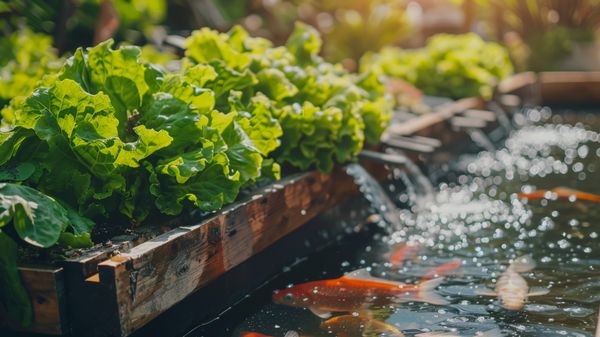To choose the right fish for your aquaponics system, evaluate climate compatibility by selecting species like tilapia for warmer temperatures or catfish for cooler environments. Make sure your tank size aligns with the recommended stocking densities, typically one inch of fish per gallon.
Monitor dietary needs by providing appropriate feed that supports nutrient uptake from plant waste. Prioritize hardiness by opting for disease-resistant species to mitigate health risks.
Finally, confirm local regulations regarding fish species and water quality measures. Understanding these key factors lays the groundwork for an effective aquaponics system, enhancing both fish and plant productivity. More insights will follow.
Climate and Water Temperature
When choosing fish for your aquaponics system, understanding climate and water temperature is crucial. The specific climate impact on your choice can markedly affect both fish health and plant growth.
For tropical climates, tilapia, barramundi, and jade perch thrive best at temperatures ranging from 75-85°F (24-29°C). In contrast, if you’re situated in a temperate climate, species like catfish and largemouth bass require closer temperature monitoring, as they prefer a wider range but still benefit from consistency. Ensuring compatibility with plants helps avoid competition and harm, further promoting healthy growth.
To guarantee a harmonious ecosystem, select fish species that align with local climate conditions, minimizing drastic temperature regulation adjustments. Fish with broader temperature tolerances are beneficial in regions with fluctuating temperatures, as they maintain health without added stress.
Additionally, it’s crucial to recognize the interplay between fish health and water temperature, as deviations beyond their preferred ranges can lead to increased stress, affecting growth rates and overall well-being.
Always monitor and maintain ideal water quality parameters to support both fish and plant requirements, aiming to keep the environmental conditions in the perfect range of 17-34°C (68-86°F). This attention will foster thriving aquaponics systems, promoting a sense of belonging in your aquatic gardening community.
Space and Tank Size
A well-designed aquaponics system not only considers climate and water temperature but also the available space and tank size. By understanding the tank dimensions, you’ll guarantee a stable aquatic habitat for your fish.
Ideally, you should start with a tank size of at least 100 to 150 gallons, which provides the water volume necessary for a balanced ecosystem and supports better fish growth. Remember, the dimensions of your tank directly affect how many fish you can keep; overcrowding can lead to stress and disease, undermining your efforts. Additionally, maintaining a balance between fish and plants is essential for ensuring system stability. A well-sized tank facilitates beneficial bacteria growth, which is crucial for nutrient conversion in the aquaponic cycle.
For larger fish, aim for a stocking density of 1 pound of fish per 5 to 10 gallons of water in tanks greater than 50 gallons. In smaller tanks, you’ll need to adhere to the guideline of 1 inch of fish per gallon.
It’s crucial to optimize your system layout, perhaps by using vertical space, to guarantee both adequate swimming space and effective filtration. Balancing the fish tank with your grow beds not only maximizes efficiency but also promotes a thriving aquatic ecosystem where both fish and plants can flourish.
Fish Diet and Feeding Habits
Understanding your fish’s diet and feeding habits is essential for creating a thriving aquaponics system. When choosing fish food, select products that meet the specific dietary requirements of your species, ensuring a well-balanced nutrient profile consisting of protein, lipids, carbohydrates, vitamins, and minerals. As your fish grow, adjust your feed selection to match their growth stages—fry, juveniles, and adults—all while maintaining diet diversity to promote ideal health.
Implement effective feeding strategies by providing meals 2-3 times daily, but be cautious to only offer what they can consume in about five minutes. Balanced feed input is crucial for the overall health of both fish and plants in the system. Additionally, maintaining optimal water conditions promotes better digestion and nutrient absorption.
Keep an eye on water conditions, adapting feeding quantities with seasonal changes and temperature variations. Manual feeding enables monitoring of fish behavior, while targeted feeding areas help minimize competition.
Utilize sinking pellets for bottom-dwelling species, ensuring that all fish have equitable access to food.
Lastly, maintain thorough records of the total feed added, and adjust feeding as needed based on fish growth rates and water quality.
Hardiness and Disease Resistance
When selecting fish for your aquaponics system, it’s vital to take into account their hardiness and disease resistance, as these traits greatly influence overall system stability.
Fish like tilapia and trout exhibit a range of tolerance to environmental fluctuations, and their inherent disease resistance can help mitigate the risk of outbreaks. Additionally, understanding the stress levels of these species allows you to create ideal conditions that promote health and growth, ensuring a thriving aquaponics ecosystem. Furthermore, investing in healthy fish minimizes loss risks, ensuring economic efficiency in your aquaponics operation.
Disease Resistance Benefits
Selecting disease-resistant fish is essential for the success of your aquaponics system. These fish often possess genetic traits that enhance their defenses against specific pathogens, resulting in minimal symptoms when challenges arise, which is significant in preventing the spread of diseases.
Opting for fish with documented pathogen tolerance not only allows for a more resilient ecosystem but also reduces your reliance on constant interventions, such as chemical treatments, that can disrupt the balance of your aquaponics setup.
Moreover, hardy fish, like tilapia and catfish, exemplify this concept well, as they adapt effectively to fluctuating water conditions while maintaining their health. Selecting species that exhibit disease resistance will help ensure that your system is equipped to handle potential pathogen threats more effectively.
Understanding and selecting species that are more resilient means you’ll enjoy a more stable operation that thrives under less-than-ideal circumstances.
Additionally, regularly monitoring environmental factors, including water quality, temperature stability, and nutrient levels, is essential in maximizing the inherent disease resistance of your fish.
Stress and Tolerance Levels
Many aquaponics enthusiasts overlook the critical role that stress and tolerance levels play in maintaining fish health. Understanding these factors is essential to guarantee longevity and overall well-being within your system. Each fish species varies in hardiness, and their respective tolerance to environmental fluctuations can affect their susceptibility to disease.
To effectively manage stress and promote fish health, consider the following:
- Monitor Stress Indicators: Keep an eye out for changes in behavior, such as hyperexcitability or loss of equilibrium, which can signal stress.
- Implement Stress Alleviation Strategies: Gradually change water conditions and maintain stable temperatures to reduce environmental stressors.
- Choose Hardy Species: Opt for fish that exhibit high resilience to temperature, pH fluctuations, and ammonia levels, thereby decreasing disease vulnerability. Maintaining optimal water quality is also crucial for the overall health of the fish in your aquaponics system.
Growth Rate and Size
Rapid growth rates and manageable sizes are significant factors to contemplate for successful aquaponics system management. When selecting fish, you should prioritize species known for their rapid growth, like tilapia, as they offer a substantial yield efficiency, ensuring a consistent supply of nutrients for your plants. A quick growth comparison shows that these fish can reach market size within 9-12 months under ideal conditions, allowing for efficient harvesting cycles that can maximize your system’s output.
Moreover, consider the adult size of your chosen fish in relation to the available space within your aquaponics setup. Providing adequate space per fish is essential to avoid overcrowding, which can lead to deteriorating water quality and compromised fish health. Large tanks promote more stable water conditions, fostering better growth rates and overall system balance. Understanding and importance of fish to plant ratio is crucial in ensuring that fish numbers effectively match plant needs, enhancing nutrient efficiency within the system.
Monitor your system’s capacity, aligning fish sizes with its filtration capabilities to maintain ideal water quality. Balancing your fish growth rates with the nutrient uptake of your plants will prevent deficiencies or excesses, further contributing to a harmonious and productive aquaponics environment.
Compatibility With Intended Plants
When it comes to aquaponics, confirming compatibility between your chosen fish and the intended plants is essential for a thriving system. You need to take into account the nutrient balance and how the specific waste output from your fish aligns with the nutrient requirements of the plants you want to grow. Since different plant varieties necessitate varying nutrients, matching them appropriately is critical to your system’s success.
Here are three key factors to keep in mind:
- Nutrient Requirements: Fruiting plants like tomatoes and peppers typically require more nutrients than leafy greens.
- Fish Waste Type: Fish like tilapia produce nutrient-rich waste that supports leafy greens and herbs well, while trout require higher oxygen levels and pristine water conditions suitable for compatible plant species. Understanding aquaponics might also reveal how fish serve as a crucial source of fertilizer for your plants.
- Plant-Fish Research: Investigate specific plant-fish combinations to facilitate nutrient absorption and confirm overall system health.
Local Regulations and Ethics
Maintaining compatibility between your fish and plants is just one part of running a successful aquaponics system; understanding local regulations and ethics is equally important.
As an operator, you must adhere to local regulations that mandate consistent water quality testing, including parameters such as pH, ammonia, nitrite, and nitrate levels, along with implementing appropriate sanitation methods like UV treatment and regular inspections.
It’s also important to include energy-efficient practices in your system to minimize energy consumption for pumps and lighting.
Documenting these tests thoroughly isn’t only a legal requirement but also an ethical obligation to guarantee safe practices. Moreover, fish handling must encompass biosecurity measures, including protocols for disease prevention and quarantine, emphasizing ethical considerations related to animal welfare.
It’s crucial to avoid overcrowding and to manage feeding adequately to promote healthy fish populations. Water conservation is also a significant benefit of aquaponics systems, as they require significantly less water than traditional farming methods.
Sustainability is another significant aspect to reflect upon; you need to utilize eco-friendly practices throughout your operations, assuring minimal environmental impact. Obtaining necessary permits and reporting your activities are critical for compliance with local, state, and federal regulations. Ultimately, by following these guidelines, you foster consumer trust and accountability, creating a community around your aquaponics initiative that values both ethical farming and environmental stewardship.
Frequently Asked Questions
What Are the Local Regulations for Fish Farming in My Area?
To understand local regulations for fish farming, you’ll need to obtain the necessary fish farming licenses, which typically involve registering your facility and making certain compliance with specific state laws regarding aquaculture.
Consult local fish regulations that detail licensing requirements, health standards, and environmental considerations. It’s important to coordinate with state authorities, as they enforce these regulations and may require additional permits relating to environmental impacts and water quality management. Ascertain compliance to avoid penalties.
Are There Ethical Considerations for Using Certain Fish Species?
When selecting fish species, you must consider both fish welfare and environmental impact. Prioritize sustainable sourcing practices that guarantee ethical treatment while evaluating species compatibility with your system’s conditions, including temperature and pH levels, to mitigate stress.
Monitor water quality meticulously, as improper parameters can severely affect fish health. Collaborating with animal welfare organizations can aid in establishing ethical practices, guaranteeing a balance between productive aquaculture and ecological responsibility.
Can I Mix Different Fish Species in My Aquaponics System?
Mixing different fish species in your aquaponics system can enhance tank dynamics, but you must consider species compatibility. Ascertain the fish have similar environmental needs, such as temperature and pH levels, to thrive together. Avoid mixing carnivorous and herbivorous species to prevent predation.
Regularly monitor water quality and fish health, as maintaining a balanced ecosystem is vital. Consequently, selecting compatible species is essential for a successful and harmonious aquaponic environment.
How Do I Source Fish Sustainably for My System?
To source fish sustainably for your system, prioritize species that fit your environmental conditions while adhering to local regulations. Engage with certified suppliers focused on responsible aquaculture practices, and prefer local sources to minimize transportation emissions. Ascertain the fish are disease-free by implementing quarantine measures before introduction.
What Is the Best Way to Introduce New Fish to My Tank?
Introducing new fish to your tank requires careful consideration of fish acclimation techniques while ensuring your tank environment stability. First, avoid rushing the process; allow beneficial bacteria to establish fully. Use a drip acclimation method to adjust water conditions gradually, ensuring temperatures equilibrate.
Monitor water parameters closely post-introduction, adjusting feeding and flow rates as necessary to accommodate the increased bio-load. Finally, prioritize hardy fish species to enhance your system’s overall resilience and productivity.
Conclusion
Choosing the right fish for your aquaponics system involves careful consideration of various factors, including climate, tank size, and fish compatibility with plants. Just as a robust Kubernetes architecture requires precise configuration to guarantee peak performance, selecting the appropriate fish species is critical for creating a flourishing ecosystem. By aligning these components strategically, you’ll establish a sustainable and productive aquaponics environment capable of thriving over time, ultimately leading to successful integration of aquatic and plant life in your system.




